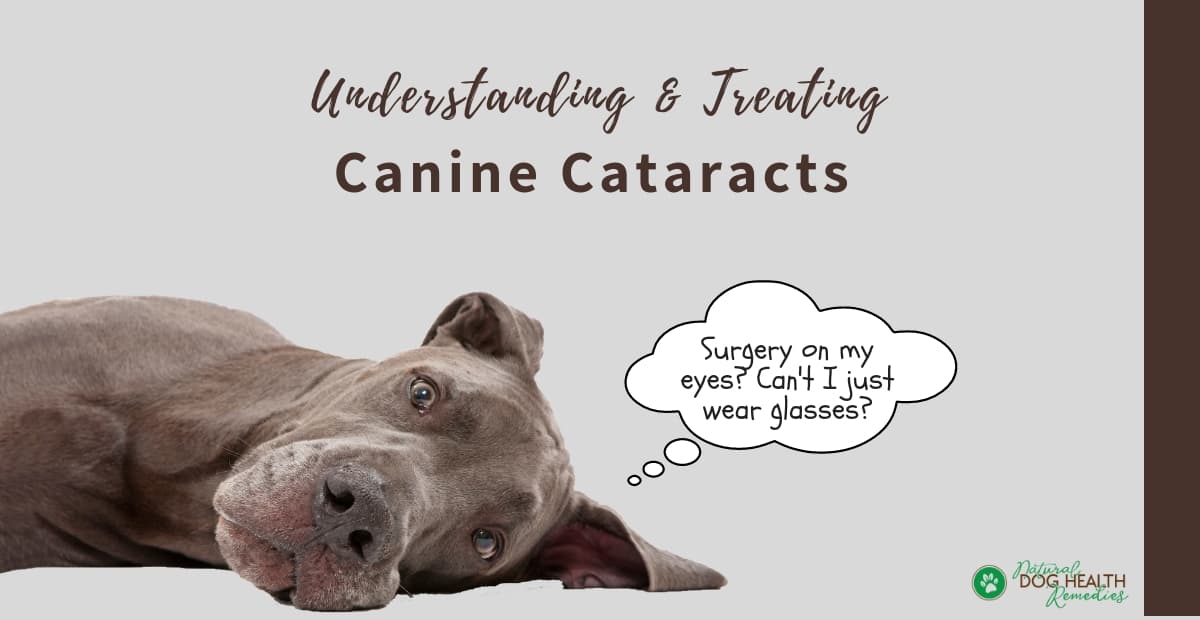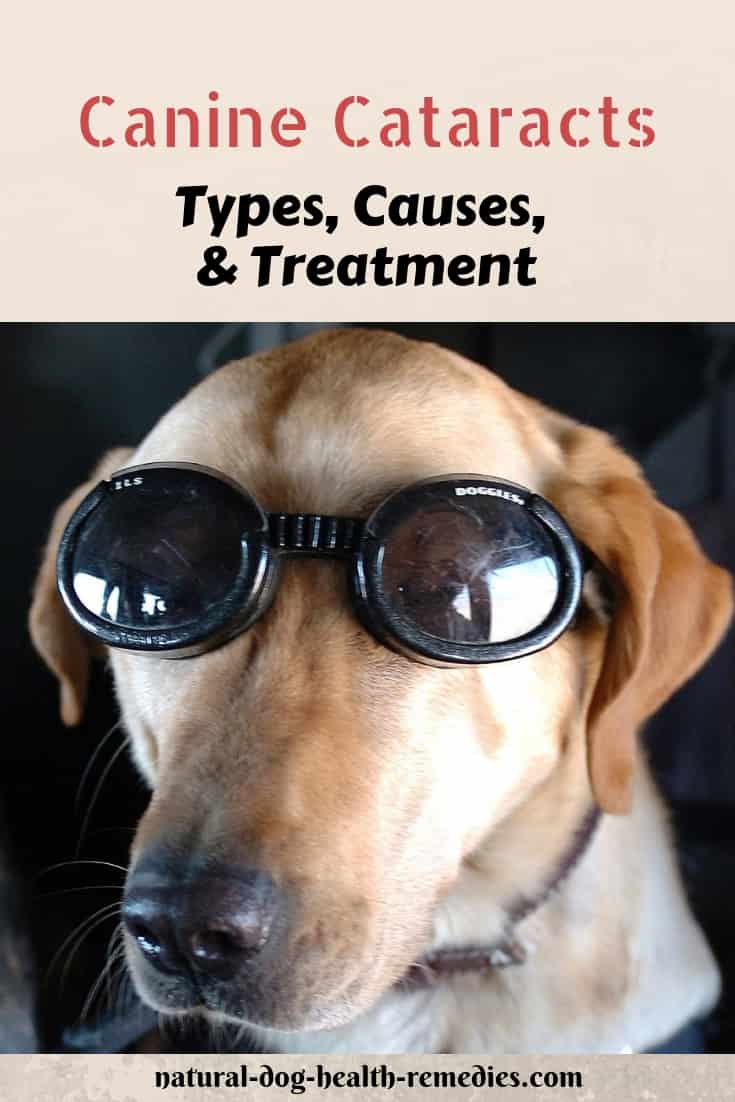Canine Cataracts

Overview
Like people, dogs suffer from cataracts too. A cataract is simply any opacity or "clouding" in the lens. A healthy lens consists of 66% water and 33% protein, and under normal conditions, this water/protein ratio is always kept in balance.
Cataracts occur when the biomechanical system in the lens is changed or damaged, resulting in the formation of large amounts of proteins in the lens.
The extra proteins cause the lens to lose its transparency, making the pupil of the eye appear cloudy or milky white.
Stages of Cataracts in Dogs
When a cataract starts to develop, the clouding is insignificant and usually does not affect your dog's vision. Cataracts at this stage are referred to as "incipient cataracts".
When a cataract becomes bigger and starts to cloud a larger area of the lens, it causes some blurred vision. Cataracts at this stage are referred to as "immature cataracts".
Over time, the entire lens can become cloudy and the dog will lose all vision in that eye. Cataracts at this stage are referred to as "mature cataracts".

Cataracts and Nuclear Sclerosis
Not all cloudy eyes are as a result of cataracts.
A much more common condition known as nuclear sclerosis (NS), which occurs when eye tissues become harder and more rigid over time, can make the eyes look slightly bluish gray.
Nuclear sclerosis is a normal physical change that occurs in the lens of older dogs (over 6 or 7 years old) and it usually occurs in both eyes at the same time.
Unlike cataracts, NS does not have a serious effect on a dog's vision and no treatment is needed.
Types and Causes of Cataracts in Dogs
There are three types of canine cataracts:
Congenital Cataracts
Some puppies are born with cataracts and this type of cataracts is called congenital cataracts.
Usually congenital cataracts occur in both eyes and are either inherited or caused by infections or toxins while the puppies are still unborn.
Congenital cataracts affect quite a few breeds of dogs (around 75 breeds in total), such as the Golden Retrievers, Labrador Retrievers, Rottweilers, Cocker Spaniels, Miniature Schnauzers, Standard Poodles, Siberian Huskies, among others.
Developmental Cataracts
When a dog develops cataracts early on in life (before 6 years old), we say he has developmental cataracts. Developmental cataracts may be inherited or caused by external factors. The most common causes are:
- Injuries and trauma to the eye;
- Diabetes mellitus (it is estimated that 68% - 75% of diabetic dogs will develop cataracts within one year of diagnosis);
- Infection;
- Other eye diseases (e.g. glaucoma, uveitis, progressive retinal atrophy) can can cause cataracts in dogs;
- Toxicity (free radicals - the harmful oxygen molecules in the body - can gradually damage the eye tissues causing cataracts).
Senile Cataracts
Like us, dogs also develop cataracts when they become older (often after 6 or 7 years old).
Conventional Treatment of Canine Cataracts
 If your dog has been diagnosed with cataracts, it is advisable to consult a veterinary ophthalmologist to see if your dog is a suitable candidate for surgery.
If your dog has been diagnosed with cataracts, it is advisable to consult a veterinary ophthalmologist to see if your dog is a suitable candidate for surgery.
If surgery is suggested, then it should be done as soon as possible before the cataract develops into a mature one, since the surgical outcome is better for immature cataracts.
Your dog will have to be put under general anesthesia for the surgery. If you have an older dog, it is advisable to ask your vet to do a blood test to see if your dog's liver is healthy since the anesthetic drugs are metabolized by the liver.
Cataracts typically cause eye inflammation, so if your dog has an inflamed eye, it has to be treated (by either steroidal or non-steroidal eye drops) before the cataract surgery.
The surgery involves making an incision in the eye and a procedure called "phacoemulsification" is used to remove the cloudy lens from the lens capsule. In most cases, the lens is permanently replaced by lens implant (a procedure called "intraocular lens implantation").
This treatment for cataracts in dogs is becoming more common and very often has a very high success rate, in which the dog can see close to normal.
A study in 2011 was done on dogs with cataracts. It divided 44 dogs into 3 groups and compared the outcomes for each group:
- Group 1: no treatment at all
- Group 2: topical medical treatment
- Group 3: phacoemulsification with intraocular lens implantation
The study found that regardless of the stage of cataract a dog had, the chance of success was 4 times higher for eyes undergoing phacoemulsification than for eyes that received medical management only.
This shows that if a dog is diagnosed with cataracts, prompt surgery should be the preferred treatment for the dog to restore normal or near-normal vision.
Are There Any Risks?
As in all surgical procedures, there are some risks and possible complications.
Possible risks include:
- Tissue Scarring: Dogs tend to have more inflammation in their eyes after surgery than humans and therefore they may have more scarring, which can slightly decrease vision.
- Uveitis and Glaucoma: Uveitis is the inflammation of the eye, which can lead to glaucoma.
Glaucoma occurs in 30% of all dogs who have cataract surgery, usually within the first 24 hours after surgery. In many cases this condition is temporary and can be resolved with timely treatment. If untreated, however, glaucoma is painful, and can cause complete vision loss.
- Detachment of the Retina: Re-attachment has a low success rate and this complication usually results in complete vision loss.
Prevention of Canine Cataracts
Note that remedies such as herbal eye drops and vitamins cannot cure cataracts in dogs.
However, proper use of some natural supplements can greatly help prevent or delay the onset of cataracts. Read this article for more information.

Eldredge, et al. Dog Owner's Home Veterinary Handbook 4th edition (Wiley Publishing, 2007).
Merck Publishing and Merial. The Merck/Merial Manual for Pet Health (Merck, 2007).
M. Goldstein, The Nature of Animal Healing (Ballantine Books, 2000).





